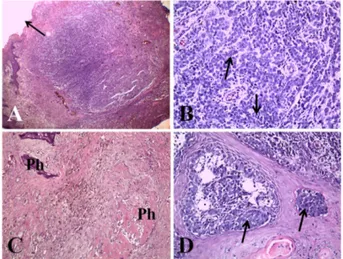pISSN 2466-1384 eISSN 2466-1392 Korean J Vet Res (2019) 59(4):219~222 https://doi.org/10.14405/kjvr.2019.59.4.219
219 CASE REPORT
Nailbed malignant melanoma in three dogs
Hyoung-Nam Jo
1,†, Myeong-Won Suh
1,†, Joo-Ok Lee
2, Jae-Hoon Kim
1,*
1
College of Veterinary Medicine and Veterinary Medical Research Institute, Jeju National University, Jeju 63243, Korea
2
Ekklim Anima Hospital, Daegu 41165, Korea
Abstract: Three 8-12-year-old male cocker spaniels presented with an appendicular mass accompanied by pain, inflammation, lameness, and loss of nail in the digits of the forelimb or hindlimb. A histological examination revealed dermal masses of the digit composed of numerous neoplastic cells with marked pleomorphism and high mitosis. The neoplastic cells showed a strong invasive tendency into the epidermis and adjacent bony tissues, such as distal phalanx. Immunohistochemistry of the neoplastic cells in three masses revealed positive reactions for Melan-A. These three dogs were diagnosed as nailbed malignant melanoma in the digit based on the history, clinical signs, and histopathologic features.
Keywords: digit, distal phalanx, dog, Melan-A, nailbed malignant melanoma
Melanoma is a malignant tumor arising from melanocytes, which produce melanin and are derived from neuroectodermal melanoblasts in the epidermis or adnexa structures, but primarily from the external root sheath of the hair follicle [1]. Malignant melanoma is common in dogs but uncommon in other domestic animals [1]. Canine melanocytic tumors occur most frequently in the oral cavity and the haired skin, or around the lips [1,2]. In dogs, this tumor accounts for 3% of all neoplasm and up to 7% of all malignant tumors [2].
Nailbed (human term ‘subungual’) malignant melanoma is derived from the melanocytes of the nailbed epithelium [1]. Nailbed malignant melanoma is common only in dogs and accounts for approximately 8% of malignant mela- noma cases [1]. The digits affected by subungual melanoma often have deformed nails, growth of a mass from the nailbed, or paronychia [1,2].
Several cases of malignant melanoma have been reported in the oral cavity, limbs, and digits of dogs in Korea [3-5]. Only two cases of malignant mela- noma on the digit of the forelimb and lower limb in dogs have been described in Korea [3,5], but an immunohistochemical diagnosis was not applied in those cases. This report describes the histopathological and immunohisto- chemical features in three cases of nailbed malignant melanoma in the digits of dogs in Korea.
The first dog (case one) presented with an abnormal digital swelling mass and pain, and the second dog (case two) had a rapid grown digital mass near nail and lameness (Table 1). After being bitten by another dog one month ear- lier, an abnormal mass appeared in that digit of the second dog. The third dog (case 3, Fig. 1) presented to the animal hospital with a four-month history of swelling, inflammation, and loss of nail in the 4th digit of the right forelimb.
No previous trauma to the digit could be recalled in case one and three.
Abnormal growth of the mass without any significant changes to the distal phalange at the affected digits was observed in these dogs using a radio- graphic examination according to field clinicians (Fig. 2A). No recurrence of neoplasm and metastasis was observed eight months after surgery in case 3 (Fig. 2B). Unfortunately, follow-up monitoring could not be performed in the other two dogs.
The masses, with/without distal and middle phalanges in the digits of dogs, were excised completely under local anesthesia. After surgery, the masses were fixed in 10% buffered formalin and submitted to the pathology labora-
*Corresponding author Jae-Hoon Kim
College of Veterinary Medicine and Veterinary Medical Research Institute, Jeju National Uni- versity, Jeju 63243, Korea
Tel: +82-64-754-3387 Fax: +82-64-702-9920 E-mail: kimjhoon@jejunu.ac.kr
†
